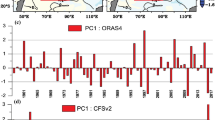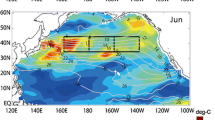Abstract
The Tropical Indian Ocean (TIO) is seen to exhibit robust warming after the 1950s. Most of the previous studies on the Indian Ocean (IO) surface and subsurface temperature focussed on long-term trends and interannual variability. The multidecadal to decadal variability in the Eastern Equatorial Indian Ocean (EEIO, 80°E–110°E, 8°S–5°N, 50-110 m) subsurface temperature is studied using reanalysis products and ocean general circulation model (OGCM) simulations. Prior to 1990s, the EEIO subsurface temperature is found to be dominated mostly by the multidecadal variability. However, since the mid-1990s, significant decadal variability is observed, something that has not been reported before. The mechanisms responsible for the observed decadal and multidecadal variability in the EEIO subsurface temperature are studied in detail. Wind forcing along the equator, and the associated ocean dynamics are found to be the major factors responsible for the EEIO subsurface temperature variability in the decadal and multidecadal time scales, emphasizing the importance of local atmospheric forcing on this variability. Alongshore winds along the Sumatra coast also contribute considerably to the decadal changes in the EEIO subsurface temperature. It is also found that the observed decadal and multidecadal changes are independent of the phase reversal of Interdecadal pacific oscillation (IPO). OGCM sensitivity experiments also suggest that the decadal variability of EEIO subsurface temperature is largely unaffected by the oceanic pathways such as Indonesian Through Flow (ITF). Hence, remote forcing through these pathways is insignificant in the TIO subsurface temperature north of 10°S as compared to the TIO wind forcing. Consistent with EEIO subsurface temperature, equatorial IO (EIO) winds also exhibit decadal variability post mid-1990s. The major contributors for the decadal variability in EIO winds are found to be the decadal variability in the Mascarene high, the low level jet, and the large scale off-equatorial circulations.











Similar content being viewed by others
References
Alexander MA (2010) Extratropical air-sea interaction, sea surface temperature variability, and the Pacific decadal oscillation. In: Sun D, Bryan F (eds) Climate dynamics: Why does climate vary? AGU Monograph #189, Washington, pp 123–148
Alory G, Meyers G (2009) Warming of the upper equatorial Indian Ocean and changes in the heat budget (1960–99). J Clim 22(1):93–113. https://doi.org/10.1175/2008JCLI2330.1
Annamalai H, Potemra J, Murthugudde R, McCreary JP (2005) Effect of preconditioning on the extreme climate events in the tropical Indian Ocean. J Clim 18:3450–3469. https://doi.org/10.1175/JCLI3494.1
Ashok K, Chan WL, Motoi T, Yamagata T (2004) Decadal variability of the Indian Ocean dipole. Geophys Res Lett 31:L24207. https://doi.org/10.1029/2004GL021345
Bader J, Latif M (2005) North Atlantic Oscillation response to anomalous Indian Ocean SST in a coupled GCM. J Clim 18:5382–5390. https://doi.org/10.1175/JCLI3577.1
Balmaseda MA, Mogensen K, Weaver AT (2013) Evaluation of the ECMWF ocean reanalysis system ORAS4. Q J R Meteorol Soc 139:1132–1161. https://doi.org/10.1002/qj.2063
Chakravorty S, Gnanaseelan C, Chowdary JS, Luo J-J (2014) Relative role of El Niño and IOD forcing on the southern tropical Indian Ocean Rossby waves. J Geophys Res 119:5105–5122. https://doi.org/10.1002/2013JC009713
Chen G, Han W, Li Y, Wang D (2016) Interannual variability of equatorial eastern Indian Ocean upwelling: local versus remote forcing. J Phys Ocean 46:789–807. https://doi.org/10.1175/JPO-D-15-0117.1
Dee DP et al (2011) The ERA-Interim reanalysis: configuration and performance of the data assimilation system. Q J R Meteorol Soc 137:553–597. https://doi.org/10.1002/qj.828
Deepa JS, Gnanaseelan C, Kakatkar R, Parekh A, Chowdary JS (2018) The interannual sea level variability in the Indian Ocean as simulated by an ocean general circulation model. Int J Climatol 38:1132–1144. https://doi.org/10.1002/joc.5228
Deepa JS, Gnanaseelan C, Mohapatra S, Chowdary JS, Karmakar A, Kakatkar R, Parekh A (2019) The tropical Indian Ocean decadal sea level response to the Pacific decadal oscillation forcing. Clim Dyn 52:5045–5058. https://doi.org/10.1007/s00382-018-4431-9
Deser C, Phillips AS (2006) Simulation of the 1976/1977 climate transition over the North Pacific: sensitivity to tropical forcing. J Clim 19:6170–6180. https://doi.org/10.1175/JCLI3963.1
Deshpande A, Chowdary JS, Gnanaseelan C (2014) Role of thermocline–SST coupling in the evolution of IOD events and their regional impacts. Clim Dyn 43:163–174. https://doi.org/10.1007/s00382-013-1879-5
Dong L, McPhaden MJ (2017) Why has the relationship between Indian and Pacific Ocean decadal variability changed in recent decades? J Clim 30:1971–1983. https://doi.org/10.1175/JCLI-D-16-0313.1
Dong L, Zhou T, Dai A, Song F, Wu B, Chen X (2016) The footprint of the inter-decadal Pacific oscillation in Indian Ocean sea surface temperatures. Sci Rep 6:21251. https://doi.org/10.1038/srep21251
Du Y, Xie S-P (2008) Role of atmospheric adjustments in the tropical Indian Ocean warming during the 20th century in climate models. Geophys Res Lett 35:L08712. https://doi.org/10.1029/2008GL033631
Feba F, Ashok K, Ravichandran M (2019) Role of changed Indo-Pacific atmospheric circulation in the recent disconnect between the Indian summer monsoon and ENSO. Clim Dyn 52:1461–1470. https://doi.org/10.1007/s00382-018-4207-2
Gadgil S, Vinayachandran PN, Francis PA, Gadgil S (2004) Extremes of the Indian summer monsoon rainfall, ENSO and equatorial Indian Ocean oscillation. Geophys Res Lett 31:L12213. https://doi.org/10.1029/2004GL019733
Gnanaseelan C, Deshpande A, McPhaden MJ (2012) Impact of Indian Ocean Dipole and El Niño/Southern oscillation forcing on the Wyrtki jets. J Geophys Res 117:C08005. https://doi.org/10.1029/2012JC007918
Griffies SM, Harrison MJ, Pacanowski RC, Rosati A (2004) A technical guide to MOM4. GFDL Ocean group technical report No. 5, Princeton NJ NOAA/Geophysical fluid dynamics laboratory pp 342
Han W, Vialard J, McPhaden MJ, Lee T, Masumoto Y, Feng M, Ruijter WPM (2014) Indian Ocean decadal variability: a review. Bull Am Meteorol Soc 95:1679–1703. https://doi.org/10.1175/BAMS-D-13-00028.1
Han W, Meehl GA, Hu A, Zheng J, Kenigson J, Vialard J, Rajagopalan B, Yanto (2017) Decadal variability of the Indian and Pacific Walker cells since the 1960s: Do they covary on decadal time scales? J Clim 30:8447–8468. https://doi.org/10.1175/jcli-d-16-0783.1
Hermes JC, Reason CJC (2008) Annual cycle of the South Indian Ocean (Seychelles–Chagos) thermocline ridge in a regional ocean model. J Geophys Res 113:C04035. https://doi.org/10.1029/2007JC004363
Huang B, Thorne Peter W et al (2017) Extended reconstructed sea surface temperature version 5 (ERSSTv5), upgrades, validations, and intercomparisons. J Clim 31:8179–8205. https://doi.org/10.1175/JCLI-D-16-0836.1
Karmakar A, Parekh A, Chowdary JS, Gnanaseelan C (2018) Inter comparison of Tropical Indian Ocean features in different ocean reanalysis products. Clim Dyn 51:119–141. https://doi.org/10.1007/s00382-017-3910-8
Koch-Larrouy A, Madec G, Bouruet-Aubertot P, Gerkema T, Bessières L, Molcard R (2007) On the transformation of Pacific water into Indonesian through flow water by internal tidal mixing. Geophys Res Lett 34:L04604. https://doi.org/10.1029/2006GL028405
Large WG, Yeager S (2009) The global climatology of an interannually varying air—sea flux data set. Clim Dyn 33:341–364. https://doi.org/10.1007/s00382-008-0441-3
Lee SK, Park W, Baringer MO, Gordon AL, Huber B, Liu Y (2015) Pacific origin of the abrupt increase in Indian Ocean heat content during the warming hiatus. Nat Geosci 8:445–449. https://doi.org/10.1038/NGEO2438
Levitus S, Antonov JI, Boyer TP, Locarnini RA, Garcia HE, Mishonv AV (2009) Global ocean heat content 1955–2008 in light of recently revealed instrumentation problems. Geophys Res Lett 36:L07608. https://doi.org/10.1029/2008GL037155
Li X, Xie S-P, Gille ST, Yoo C (2016) Atlantic-induced pantropical climate change over the past three decades. Nat Clim Change 6:275–279. https://doi.org/10.1038/nclimate2840
Li Y, Han W, Hu A, Meehl G, Wang F (2018) Multidecadal changes of the upper Indian Ocean heat content during 1965–2016. J Clim 31:7863–7884. https://doi.org/10.1175/JCLI-D-18-0116.1
Liu Z (2012) Dynamics of Interdecadal climate variability: an historical perspective. J Clim 25:1963–1995. https://doi.org/10.1175/2011JCLI3980.1
Luo J-J, Sasaki W, Masumoto Y (2012) Indian Ocean warming modulates Pacific climate change. Proc Natl Acad Sci USA 109(46):18701–18706. https://doi.org/10.1073/pnas.1210239109
Luo F, Li S, Furevik T (2018) Weaker connection between the Atlantic multidecadal Oscillation and Indian summer rainfall since the mid-1990s. Atmos Oceanic Sci Lett. https://doi.org/10.1080/16742834.2018.1394779
Mantua NJ, Hare SR, Zhang Y, Wallace JM, Francis RC (1997) A Pacific interdecadal climate oscillation with impacts on salmon production. Bull Am Meteorol Soc 78:1069–1079. https://doi.org/10.1175/1520-0477(1997)078%3c1069:APICOW%3e2.0.co;2
Mochizuki T, Kimoto M, Watanabe M, Chikamoto Y, Ishii M (2016) Inter-basin effects of the Indian Ocean on Pacific decadal climate change. Geophys Res Lett 43:7168–7175. https://doi.org/10.1002/2016GL069940
Ndah AB, Dagar L, Becek K (2017) Multi-temporal patterns of upwelling–downwelling dynamics in the South China Sea based on a 47-year time-series of the NOAA-ERD upwelling index. Reg Stud Mar Sci 16:225–239. https://doi.org/10.1016/j.rsma.2017.08.017
Nieves V, Willis JK, Patzert WC (2015) Recent hiatus caused by decadal shift in Indo-Pacific heating. Science 349:532–535. https://doi.org/10.1126/science.aaa4521
Rahul S, Gnanaseelan C (2016) Can large scale surface circulation changes modulate the sea surface warming pattern in the Tropical Indian Ocean? Clim Dyn 46:3617–3632. https://doi.org/10.1007/s00382-015-2790-z
Sanchez-Gomez E, Cassou C, Hodson DLR, Keenlyside N, Okumura Y, Zhou T (2008) North Atlantic weather regimes response to Indian-western Pacific Ocean warming: a multi-model study. Geophys Res Lett 35:L15706. https://doi.org/10.1029/2008GL034345
Schoenefeldt R, Schott FA (2006) Decadal variability of the Indian Ocean cross-equatorial exchange in SODA. Geophys Res Lett 33:L08602. https://doi.org/10.1029/2006GL025891
Susanto RD, Gordon AL, Zheng Q (2001) Upwelling along the coast of Java and Sumatra and its relation to ENSO. Geophys Res Lett 28(8):1599–1602. https://doi.org/10.1029/2000GL011844
Thompson B, Gnanaseelan C, Salvekar PS (2006) Variability in the Indian Ocean circulation and salinity and its impact on SST anomalies during dipole events. J Mar Res 64:853–880
Thompson PR, Piecuch CG, Merrifield MA, McCreary JP, Firing E (2016) Forcing of recent decadal variability in the Equatorial and North Indian Ocean. J Geophys Res Oceans 121:6762–6778. https://doi.org/10.1002/2016JC012132
Tozuka T, Luo JJ, Masson S, Yamagata T (2007) Decadal modulations of the Indian Ocean Dipole in the SINTEX-F1 coupled GCM. J Clim 20:2881–2894. https://doi.org/10.1175/JCLI4168.1
Trenary LL, Han W (2008) Causes of decadal subsurface cooling in the tropical Indian Ocean during 1961–2000. Geophys Res Lett 35:L17602. https://doi.org/10.1029/2008GL034687
Ummenhofer CC, Schwarzkopf FU, Meyers G, Behrens E, Biastoch A, Böning CW (2013) Pacific Ocean contribution to the asymmetry in eastern Indian Ocean variability. J Clim 26:1152–1171. https://doi.org/10.1175/JCLI-D-11-00673.1
Ummenhofer CC, Biastoch A, Böning CW (2017) Multi-decadal Indian Ocean variability linked to the pacific and implications for preconditioning Indian Ocean Dipole events. J Clim 30:1739–1751. https://doi.org/10.1175/JCLI-D-16-0200.1
Uppala S et al (2005) The ERA-40 re-analysis. Q J R Meteorol Soc 131:2961–3012. https://doi.org/10.1256/qj.04.176
Vaid BH, Gnanaseelan C, Polito PS, Salvekar PS (2007) Influence of pacific on Southern Indian Ocean Rossby waves. Pure Appl Geophys 164:1765–1785. https://doi.org/10.1007/s00024-007-0230-7
Wang B, Wu R, Li T (2003) Atmosphere—warm ocean interaction and its impact on Asian-Australian monsoon variation. J Clim 16:1195–1211. https://doi.org/10.1175/1520-0442(2003)16%3c1195:AOIAII%3e2.0.CO;2
Xue et al (2012) A comparative analysis of upper ocean heat content variability from an ensemble of operational ocean reanalyses. J Clim 25:6905–6929. https://doi.org/10.1175/JCLI-D-11-00542.1
Zhou XB, Alves O, Marsland SJ, Bi Daohua, Hirst AC (2017) Multi-decadal variations of the south Indian ocean subsurface temperature influenced by pacific decadal oscillation. Tellus A 69:1–12. https://doi.org/10.1080/16000870.2017.1308055
Acknowledgments
We thank Director, ESSO-IITM and Ministry of Earth Sciences (MoES), Government of India for the support. Sandeep Mohapatra thanks IITM for research fellowship. Comments from the anonymous reviewers have helped us to improve the manuscript. We acknowledge Deepti Gnanaseelan for language edits. ERSSTv5 data is from https://www.esrl.noaa.gov/psd/data/gridded/data.noaa.ersst.v5.html. ORAS4 temperature data is downloaded from Asia–Pacific Data Research Centre (APDRC) (http://apdrc.soest.hawaii.edu/data/data.php). ERA40 and Interim wind data at surface levels are taken from http://apps.ecmwf.int/datasets/. Figures are prepared using PyFerret and Python.
Author information
Authors and Affiliations
Corresponding author
Additional information
Publisher's Note
Springer Nature remains neutral with regard to jurisdictional claims in published maps and institutional affiliations.
Rights and permissions
About this article
Cite this article
Mohapatra, S., Gnanaseelan, C. & Deepa, J.S. Multidecadal to decadal variability in the equatorial Indian Ocean subsurface temperature and the forcing mechanisms. Clim Dyn 54, 3475–3487 (2020). https://doi.org/10.1007/s00382-020-05185-7
Received:
Accepted:
Published:
Issue Date:
DOI: https://doi.org/10.1007/s00382-020-05185-7




